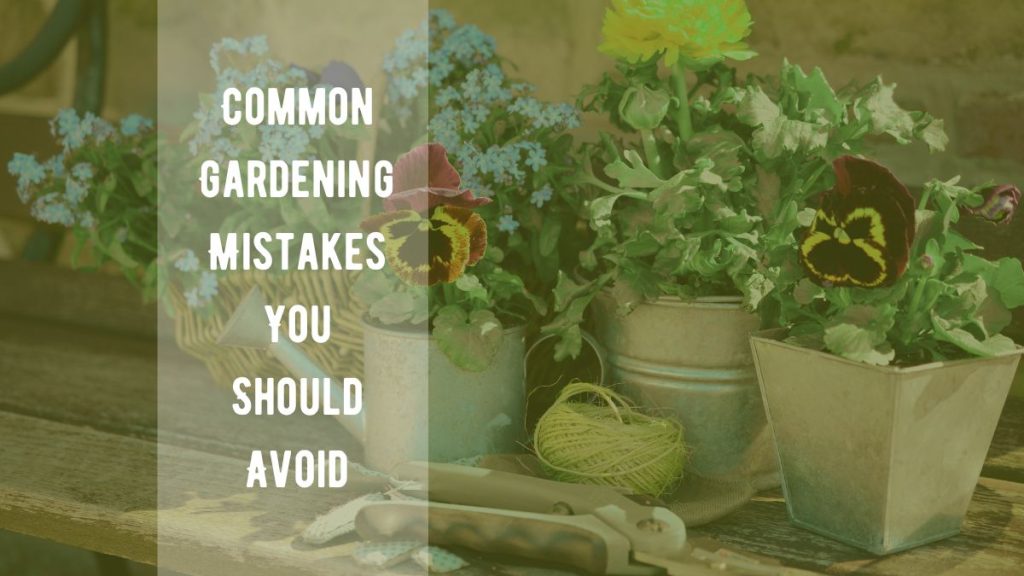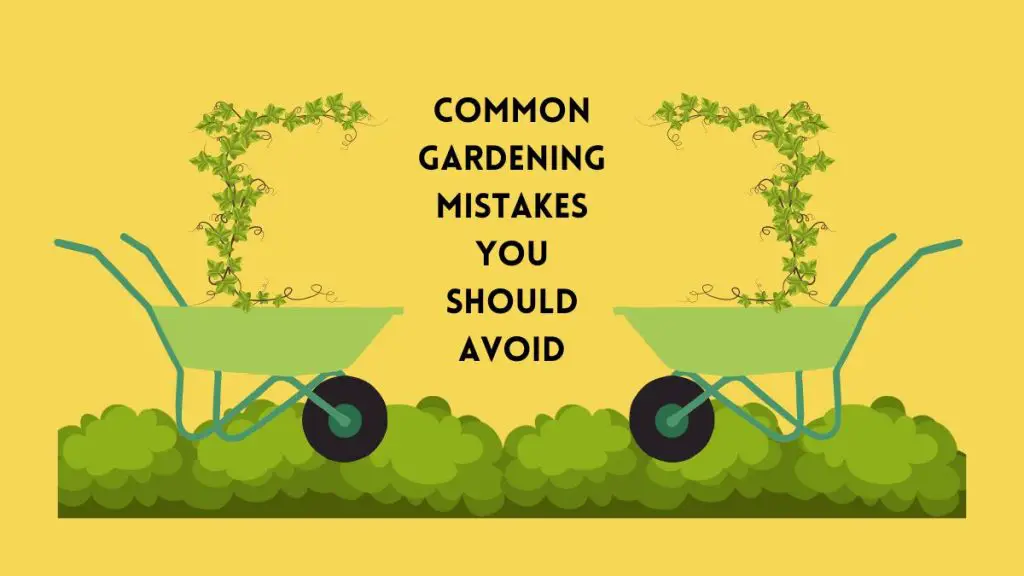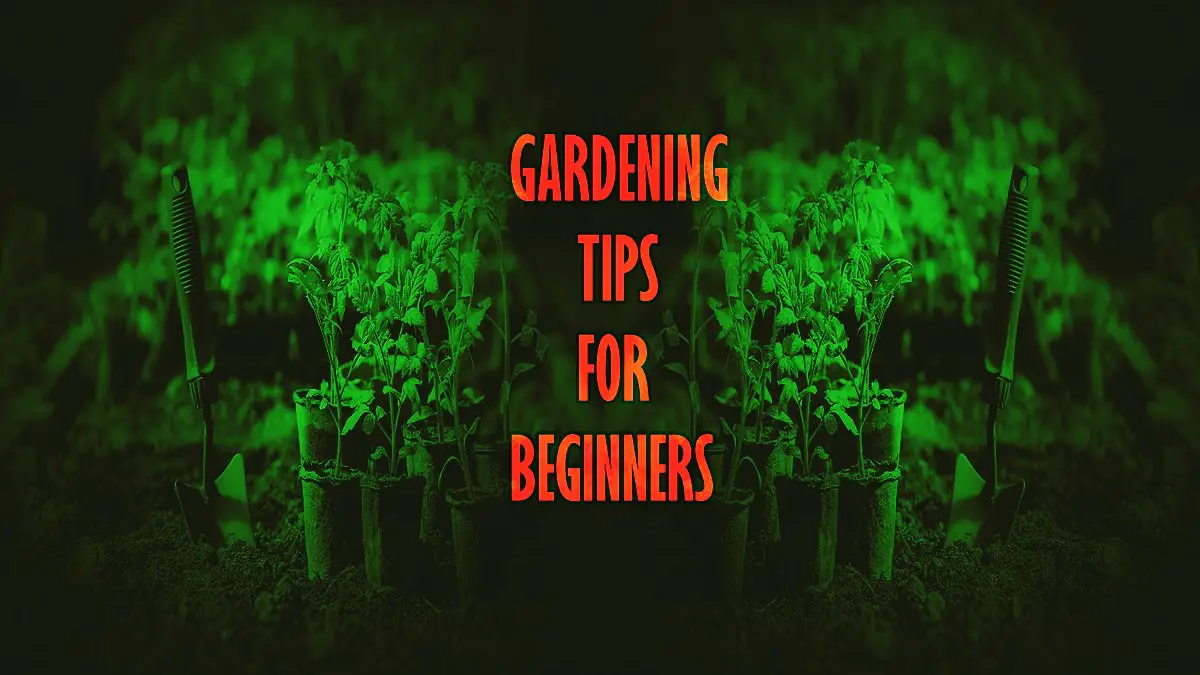The top 10 common gardening mistakes include overwatering plants and neglecting soil health. Incorrect plant spacing and over-fertilizing also lead many gardeners astray.
Gardening can be a fulfilling and rewarding hobby, but it’s easy to fall into certain traps that hinder plant growth and garden vitality. Beginners and seasoned gardeners alike often stumble on common pitfalls that can lead to less-than-lush results. From ignoring the importance of light requirements to forgetting about pest control, these blunders can discourage the greenest of thumbs.
Successful gardening is much more than just putting plants into the ground; it’s a delicate balance of care, attention, and understanding plant needs. By addressing the frequent errors made by many, this guide aims to equip gardeners with the knowledge to cultivate a flourishing garden. Knowing what to avoid is just as important as knowing what to do, ensuring your garden thrives season after season.
Related Article: Best Gardening Tips for Beginners: Cultivate Your Green Thumb
You may also read: Best Plants to Grow Under Trees – A Complete Guide

Related Article: The 14 Best Tips For Designing A Small Garden
You may also read: There are No Gardening Mistakes, Only Experiments: Grow Boldly!
Not All Soil Is Equal
Not All Soil is Equal is pivotal to remember when cultivating a thriving garden. Soil acts as the life force for your plants. Ignoring its quality and specific needs can lead to disappointing gardening results. Let’s dig into common soil mistakes to ensure your garden flourishes.
Overlooking Soil Testing
Soil testing is a step many overlook, yet it’s critical. It tells you what your soil lacks and its nutrient levels. Without this knowledge, you can’t effectively enrich your soil to support plant health. Test your soil with a kit or through a local extension service.
- Identify nutrient deficiencies.
- Learn about the soil’s texture.
- Adjust your gardening plan based on the results.
Neglecting Soil Composition And Ph
Soil composition influences water drainage and root development. Clay soils may hold water too well, while sandy soils may not hold enough. Amend soil texture for optimum plant growth.
The soil pH scale ranges from acidic to alkaline. Most plants prefer a near-neutral pH. Certain nutrients become unavailable if the pH is too high or low. Use lime to raise pH, or sulfur to lower it. Aim for the pH sweet spot for your chosen plants.
| pH Level | Soil Type | Nutrient Availability |
| Below 6.0 | Acidic | Limited calcium, magnesium |
| 6.0-7.0 | Neutral | Optimal for most plants |
| Above 7.0 | Alkaline | Iron, manganese, and phosphorus less available |
Adjusting soil composition and pH correctly leads to robust plants and bountiful harvests. Consider these soil properties as the foundation of a healthy garden.
Related Article: The Ultimate Guide to Garden Tool Organization: Maximize Efficiency

Related Article: The 11 Best Gardening Tool Sets of Recent Times
The Perils Of Incorrect Plant Placement
Plant placement in your garden is not just about aesthetics. It’s critical for plant health too. Whether it’s a vegetable patch or a flower garden, putting a plant in the wrong place can mean disaster. Let’s explore two common mistakes gardeners make.
Ignoring Sunlight Requirements
Plants have different needs when it comes to sunlight. Some thrive in full sun, while others require shade. Reading the labels on your plants or seed packets tells you their sunshine needs. Here’s a simple guide:
| Plant Type | Sunlight Needs |
| Full Sun | 6+ hours of direct sunlight |
| Partial Sun/Shade | 3-6 hours of direct sunlight |
| Full Shade | Less than 3 hours of direct sunlight |
Planting Too Close Together
Plants need room to grow. Crowding them can block light and reduce airflow. This can lead to disease or poor growth. Use these tips to space your plants right:
- Check spacing guidelines on labels or online.
- Use a ruler or a stick to measure distance when planting.
- Remember, plants grow. Allow space for full size.
Water Woes: Too Much Or Too Little
Water matters most in the garden, yet it’s easy to get it wrong. Finding the balance can be tricky. Overwatering and underwatering both spell trouble for plants. Let’s dive into these common watering pitfalls and how to avoid them.
Overwatering And Underwatering Challenges
Keeping plants healthy means giving them just the right amount of water. It’s a balancing act. Here are common signs and tips:
- Yellow leaves often mean too much water.
- Dry, wilting leaves might indicate not enough water.
- Use a soil moisture meter for accuracy.
- Water in the morning to reduce evaporation.
Inadequate Drainage Systems
Good drainage stops water from drowning your plants. Poor drainage can be a silent killer in the garden.
| Issue | Sign | Solution |
| Waterlogged soil | Standing water after rain | Raise beds or install drains |
| Compacted soil | Hard surface, slow absorption | Aerate with a fork or aerator |
Check pots for drainage holes. Consider adding organic matter like compost to improve soil structure.
Related Article: The Art of Chaos Gardening: A Unique Approach Gardening

Credit: ecogardener.com
Related Article: Top Dressing a lawn: How to Top Dress Your Lawn
Fertilization Faux Pas
When it comes to nurturing your garden, understanding fertilization is key. It’s not just about adding nutrients; it’s about finding the right balance. Step into the world of Fertilization Faux Pas and discover how to avoid common blunders that could hinder your garden’s growth.
Excessive Or Insufficient Fertilization
Too much or too little fertilizer can wreak havoc in a garden. Let’s explore the pitfalls of incorrect fertilization amounts.
- Excess fertilizer can burn roots, leading to plant damage.
- Insufficient nutrients make for weak, underperforming plants.
Balance is essential. Here are key signs to watch for:
| Fertilizer Issue | Plant Sign |
| Too Much | Yellowing leaves, stunted growth |
| Not Enough | Light green or purple-tinted foliage |
Misusing Chemicals And Organic Options
Choosing the right fertilizer is critical, yet tricky.
- Chemical fertilizers offer quick fixes but can lead to soil damage.
- Organic options enrich the soil but require patience for results.
Using fertilizers safely involves:
- Reading labels carefully.
- Applying at the right time.
- Considering the environmental impact.
Learn your plants’ needs and match the fertilizer type accordingly. Smart choices lead to a thriving garden.
Related Article: Beneficial Garden Insects for Natural Pest Control – A Complete Guide

Credit: homesteadingfamily.com
Related Article: The Ultimate Guide to Organic Gardening
Neglecting Pest And Disease Management
Gardening is a rewarding activity, yet it demands vigilance.
Risks abound, from tiny pests to destructive diseases.
Gardeners often overlook these threats, leading to plant woes.
Attention to pest and disease management is crucial for a lush garden.
Failing To Identify Common Pests
Pest identification is a gardener’s first defense.
Recognizing critters early prevents harm to your green oasis.
Eyeballing your plants often helps catch invaders on time.
- Aphids: Sap-sucking greens-drainers.
- Slugs: Munching on leaves at night.
- Spider mites: Weaving webs, yellowing leaves.
Effective diagnosis prompts timely action.
Ignoring Early Signs Of Disease
Early disease detection saves gardens.
Spotting symptoms quickly can prevent widespread damage.
Regular checks for telltale signs are essential.
| Disease | Symptoms |
| Mildew | White spots, withered leaves. |
| Blight | Brown lesions, plant decay. |
| Rust | Orange pustules, leaf drop. |
Acting upon first sight of disease preserves plant health.
Related Article: The 9 Best Garden Tool Organizers of Recent Times

Related Article: A Comprehensive Guide to Garden Pest Control Makes Garden Beautiful
Frequently Asked Questions Of Top 10 Common Gardening Mistakes
What Are Common Errors In Gardening?
Common gardening errors include overwatering, planting at the wrong time, and neglecting soil health. These mistakes can hinder plant growth and yield.
How To Avoid Over-fertilizing Plants?
To avoid over-fertilizing, use recommended amounts on product labels. Also, conduct soil tests before application to determine nutrient needs.
Can Incorrect Planting Depth Affect Plants?
Yes, incorrect planting depth can lead to poor root development and plant stress. Follow seed packet instructions or plant at a depth equal to the seed’s diameter.
Why Is Proper Sunlight Important For Gardens?
Proper sunlight is crucial as it drives photosynthesis, aiding in plant growth and flower bloom. Monitor light levels in your garden to match plant preferences.
To know more about Common Gardening Mistakes>>
Related Article: How to Start a Lawn Care Business With No Money
You may also read: Under Deck Landscaping Ideas to Decorate: Transform Your Space!
Conclusion
Steering clear of these garden blunders is key to nurturing your green haven. Remember, each plant thrives with attention and understanding. By sidestepping these missteps, you pave the way for a lush, vibrant garden. Let your gardening journey flourish by learning, adapting, and growing alongside your plants.
Embrace the dirt, cherish the growth, and reap the bountiful rewards of a well-tended garden.
Related Article: The Top 10 Best Pruning Saws for Gardeners
You may also read: Low Maintenance Garden Border Ideas: A Complete Guide to Know
You may also read: Unveiling the Beauty of a Hidden Garden
- Indoor Plant Care Tips for Enthusiasts: Lush Oasis Secrets - July 6, 2024
- The Best Electric Garden Tools: Maximize Your Green Thumb! - June 23, 2024
- Exploring the Diversity of Rock Garden Plants for Unique Gardens - June 10, 2024




Pingback: Beneficial Garden Insects for Natural Pest Control - Dwell Gardens
Pingback: Best Plants to Grow Under Trees - A Complete Guide - Dwell Gardens